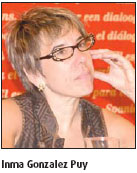Not just toreros, flamenco
 During China's cultural renaissance nearly a century ago, Spanish writer Miguel de Cervantes and his knight Don Quixote became icons for pioneers who persisted in reforming and revitalizing the ancient civilization.
During China's cultural renaissance nearly a century ago, Spanish writer Miguel de Cervantes and his knight Don Quixote became icons for pioneers who persisted in reforming and revitalizing the ancient civilization.
Qu Qiubai, one of the early founders of the Communist Party, even called the time "age of Don Quixote" in one of his articles, referring to the prevalent belief at the beginning of the 1920s that heroic individuals could save China.
Today the Cervantes Institute, a non-profit organization named after the famous author, is contributing to China's wave of cultural renaissance in the new century by bringing in a breath of fresh air in the form of the best of Spanish art and increasing options for creative thinking.
"We want to break the stereotypes about Spanish culture being just about bull fighting and flamenco, and present a vibrant contemporary art scene and also a rich tradition," said Inma Gonzalez Puy, director of the Cervantes Institute in Beijing.
"Spain should become a household name in China for its architecture, design, drama, jazz, and a variety of other arts."
A number of Chinese have been attracted to Spanish culture because it is "full of character and color," said Chen Ziming, professor at the Central Conservatory of Music in Beijing.
Exchanges between Spain and China began to flourish as soon as the latter opened its doors to the rest of the world at the end of the 1970s, said Chen, citing the conservatory's Segovia Guitar Center as an example.
Built in the 1980s, the center was named after Andrs Segovia (1893-1987), the father of the modern classical guitar movement, and has been the cradle for the blossoming of several generations of guitar players in the Middle Kingdom.
But compared with French and Italian, Spanish art, especially music, still not enjoy enough popularity in the 20th century China because the ordinary Chinese didn't have many opportunities to experience Spanish culture or become familiar with the names of great Spanish artists, Professor Chen said.
Hence, the need was felt to establish an organization specializing in the spreading of Spanish culture.
The Cervantes Institute in Beijing has organized a series of round tables about the Spanish arts, economy and history since its inauguration by Spain's Crown Prince Felipe last July, said Puy.
At these workshops, Spanish and invited Chinese experts together offer perspectives on Spain that are inspiring to audiences of both nationalities. About two-thirds of the audiences at these workshops are Chinese.
At one such round table held in the institute on June 21, popular Chinese artists Zhu Pei and Bao Pao held a round table conference with artists, architects and urban designers from Spain. The event, titled "Thinking, construction and habitation: Reflections on the new cities", was presided over by Chinese art critic Wang Mingxian and attracted a Chinese and foreign audience of about 100.
"Apparently the Chinese are very interested in Spanish architecture and urban planning, and every time there is an event on the topic, they came in large numbers," said Puy. "They care a lot about contemporary Spain."
The round table was held to coincide with a photo-exhibition on the southern Spanish region of Andalucia, which will continue at the institute until the end of August.
"We have brought the works of five photographers," said Jose Lebrero Stals, director of the Andalucia Center of Contemporary Art during his visit to Beijing.
"It can be a fascinating experience to share with the Chinese how construction transformed the Andalucia region and the life of its people."
Particularly impressive are the series of photos on diverse Andalusian families, the estate agency where the acquired their houses and finally their new residences.
The institute is also screening movies about Flamenco dancers and musicians throughout June under the theme "Flamenco for Everyone". Films by Pedro Almodovar wowed Chinese fans of the Spanish master in another previous event.
Lured by the arts and also the prospect of livelihood, the Chinese are becoming more and more passionate about learning Spanish, with about 1,000 people attending language courses at the institute.
"Our students come for different reasons: some want to travel in Spain, some look for business opportunities, while others are simply interested in the culture," said Puy.
A young student who preferred not to be identified told China Daily that she is at present an English language interpreter.
"But there are so many interpreters now and the competition is harsh," she said, adding that she would like to see if there was any way to profit from Sino-Spanish trade when she has mastered the language.
Spanish companies in China are enthusiastic about sending their staff to the courses, while the Beijing Organizing Committee for the Games of the XXIX Olympiad has 108 people learning the language so that they can accompany the Spanish delegation next year.
"The language is a bridge and so is the institute," said Puy. "Communication is an on-going activity and it will continue even after the 'big bang' of the Spanish Year in China."
(China Daily 06/27/2007 page26)














